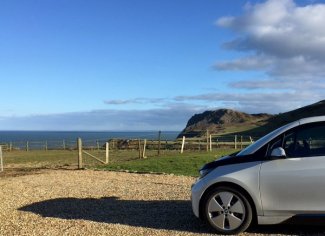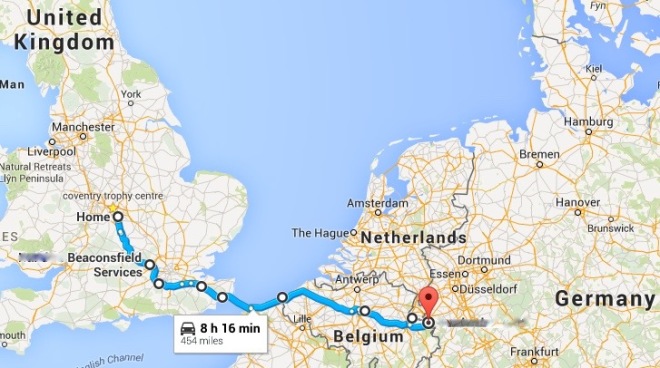
Thanks to 2016 being a leap year, today is the 366th day of us owning a BMW i3 Range Extender (REx) and worth a brief update. I couldn’t think of a better way than to post about it here.
I think it is fair to say that owning an electric car has changed the way we experience driving and mobility. Our i3 has de-facto taken over the duties of a run-around family car and commuter vehicle, all of which amount to a total daily average journey of about 35 miles. On March 1st 2015, the i3 replaced my lovely 2012 Golf Cabrio (its soft-toppability is still missed occasionally, but not its petrol engine) and runs alongside a long range 5-seather family Diesel (Nissan Qashqai). The i3 has completed over 15,000 miles in its first year with us and most of these miles have been electric (92.3% to be precise). As a result, we have seen an annual fuel saving of about £800 pounds (saved Petrol/Diesel costs less home-charging electricity costs). In addition, the car only requires two services within the first 5 years, which is covered by the service plan I purchased from Rybrook BMW Warwick.

The i3 has been reliable (putting aside some little quirks, which were mainly down to a different kind of handling) and been a pleasure to drive on both short and long distances. In its first year, we’ve taken the i3 twice to Leeds (250mi return), once to Wales (480mi return), twice to Netherlands/Belgium/Germany (1800mi combined). These were business and family holiday trips, using both rapid highway chargers and the extremely handy Range Extender petrol-powered generator engine. Coming to a decision on the Range Extender option when purchasing the i3 was a difficult choice to make. In retrospect, my wife and I are more than glad we decided to go for this nifty addition. Everyone is different, but for us it really does take the headaches out of family journeys and allows for more stress-free travelling. I mainly use it on long-distance journeys, where rapid chargers are not always available or functional. Once you have pulled up at a motorway charger and found the unit either occupied or out-of-order, you come to love the range insurance policy this little petrol engine can provide. As you can tell from our high electric mileage though (92.3%), just like all REx owners we don’t suffer from range anxiety, but from “using petrol anxiety”. As an i3 driver, you have a strong urge to go electric as often as you can. In fact, this car still holds true to one of my earliest observations I made about it: it is all about “eeking it out” and making each electron work as hard as possible. You could of course say this about many electric cars, but the difference with the i3 is that BMW even designed the car around principles of low energy footprint and recycling. Whilst I am not a fan boy, I do admire BMW for realising (and completing!) a project like the i3. It still feels like a privilege to drive one.
During our first 12 months, the car had to go back to dealerships three times: we had to have a windscreen (stone damage) replaced, get a squeaky window sorted and a software update applied (this can’t be done remotely or over-the-air). BMW servicing was friendly and helpful – on all occasions an i3 loan vehicle was given to us, which was a nice touch. However repairs are closely monitored by BMW i and it can sometimes take up to a day longer to get the fix done. This is a small price you pay for being an early adopter and driving such an advanced car.
Driving an electric car can also give you a different outlook on topics like energy consumption and generation. As I’ve mentioned on here before, I don’t think of electric vehicles as a panacea that will save the environment per se. EVs are complex when seen in the context of energy generation, but it is still important to note that there are zero tailpipe emissions when you drive fully electric. I switched to Ecotricity as energy provider, as I wanted to at least make sure we support a green electricity and gas provider. On my request, Ecotricity also installed a Economy-7 meter, which is something I would almost certainly recommend to any owner of an EV, because it allows you to charge at a cheaper rate during nighttime hours. Since December 2015, we also generate our own electricity using a Photovoltaic Solar Panel installation. Our location, installation size (4kW peak) and sunshine patterns rarely allow for direct i3 charging, but the panels provide enough electricity per year to more than offset the consumption of our house. Early estimates show that we might require about 60% of our overall electricity from the grid (including house and car), while 40% annually are “homegrown” electrons.
The BMW i3 is a great and visionary car – we are happy to own one and can’t wait to see any further future updates to its spec and lineup.





 From Calais, I’ll make my way along the E40, around Brussels and then towards Aachen. This is a trip I have done numerous times in the past – I could almost do it blindfolded. Difference this time is obviously the fact I’ll be doing the trip in an electric car, aiming to use as many Rapid Chargers as possible. CCS (Combined Charging System) rapids can charge an i3 to 80% in 25 mins, with a full 100% charge taking approximately 45 mins (nb. the i3 onboard charging electronics actively slow down any charging above 80% in order to protect battery life). CCS Rapid chargers are therefore my preference, as I don’t fancy waiting for slower fast chargers, which might take up to 4h for a full recharge from 0%.
From Calais, I’ll make my way along the E40, around Brussels and then towards Aachen. This is a trip I have done numerous times in the past – I could almost do it blindfolded. Difference this time is obviously the fact I’ll be doing the trip in an electric car, aiming to use as many Rapid Chargers as possible. CCS (Combined Charging System) rapids can charge an i3 to 80% in 25 mins, with a full 100% charge taking approximately 45 mins (nb. the i3 onboard charging electronics actively slow down any charging above 80% in order to protect battery life). CCS Rapid chargers are therefore my preference, as I don’t fancy waiting for slower fast chargers, which might take up to 4h for a full recharge from 0%.
 FastNED (NL)
FastNED (NL)
